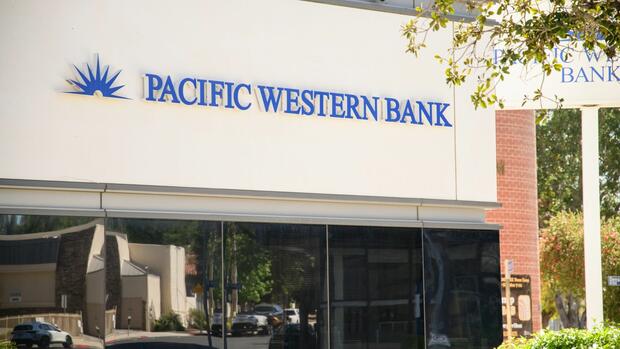The bank’s price fell sharply in after-hours trading.
(Photo: Bloomberg)
Denver Just a few hours after the US Federal Reserve announced another rate hike, regional banks have come under renewed pressure. Los Angeles-based PacWest fell 53 percent in after-hours trading. The institute is looking for a buyer and considering other strategic options, reports Bloomberg news agency. Apparently that scared investors away.
Other regional financial institutions also got caught up in the downward spiral. The Western Alliance from Phoenix in the US state of Arizona lost 24 percent in after-hours trading. Zions of Salt Lake City, Utah, fell 11 percent.
The regional bank First Republic Bank only went bankrupt at the beginning of the week and shortly afterwards was sold to America’s largest bank JP Morgan Chase. This should actually have stabilized the acute crisis, as JP Morgan CEO Jami Dimon emphasized on Monday. But concerns about the condition of the regional banks are now in focus again.
Fed Chairman Jerome Powell stressed at a press conference on Wednesday that the banking system was “robust and resilient”. As a result, monetary policymakers deemed another rate hike appropriate to further fight inflation. It was the tenth increase in a row. The key interest rate is now in the range of 5.0 to 5.25 percent.
A number of economists and investors had criticized Powell for this move. They would have preferred to see the Fed pause interest rates now. Because three regional banks have already failed since March. At the heart of the problem are the sharp rise in interest rates, which means that the bonds and loans on the banks’ books are worth significantly less. This initially led to problems at Silicon Valley Bank (SVB) and ultimately to bankruptcy, but is an issue to a lesser extent at a number of banks, as analysts emphasized.
Experts expect interest rate hikes
With higher interest rates, the Fed would get in its own way, warned Jim Lebenthal, portfolio manager at Cerity Partners. Because that would give bank customers even greater incentives to withdraw their deposits from the institutes and park them in money market funds that offer returns of four to five percent. That would weaken the regional banks even further, he argued in an interview with the US stock exchange broadcaster CNBC.
Banks have long avoided passing on interest rate increases to their savers. This was profitable for a long time, but now customers are migrating – a trend that has been exacerbated by the bankruptcy of the SVB and the subsequent bank failures. This increases the financing costs for the institutes at a time when they should actually be making provisions and preparing for increased loan defaults. “Concerns about the financial system remain unabated,” said Alan Binder, a professor of economics at Princeton University and a former vice chairman of the Fed.
>>> Read here: Highest level in 16 years: Fed continues to raise interest rates despite banking crisis
Powell had ruled out interest rate cuts on Wednesday with a high degree of probability. However, an interest rate break is foreseeable, perhaps already at the next meeting in June. But the currency watchdogs are assuming that inflation will only slowly fall again. “In that case, it wouldn’t be appropriate to cut interest rates,” Powell clarified.
Many observers, however, assume that the Fed chair is wrong here. The majority of investors are betting that interest rates could already be trimmed at the end of the year. Paul McCulley, an economics professor at Georgetown University in Washington, is one of them. “This was the Fed’s last rate hike. The next step will be a rate cut.”
More: After the collapse of First Republic: short sellers see high risks at other US banks
